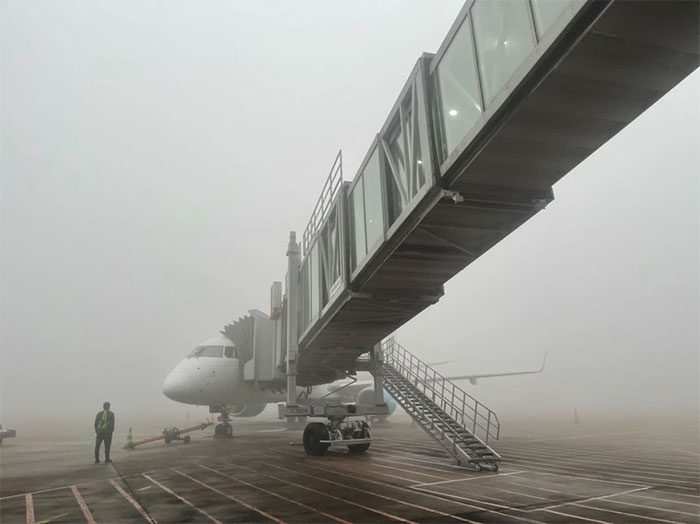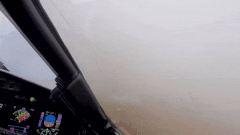In dense fog conditions, pilots need to maintain a high level of focus, which requires coordination between the pilot, air traffic controllers, and advanced aircraft technology.
Why does fog cause flight delays? What must pilots do to ensure safe takeoff and landing on the runway under limited visibility conditions?
Flight Rules in Zero Visibility Conditions
In reality, fog often occurs during the night and early morning in winter. It reduces visibility and the pilot’s ability to observe, navigate, and position the aircraft accurately. Consequently, the ability to control the aircraft for accurate takeoff and landing diminishes, increasing the risk of in-flight collisions.
Thus, flying in foggy weather presents a series of challenges, requiring smooth coordination, advanced technology, and heightened concentration. Pilots and air traffic controllers must work closely together to ensure a safe landing, even when visibility is severely restricted due to thick fog.

Dense fog at Noi Bai Airport on February 2. (Photo: Bamboo Airways).
One of the crucial principles applied in such situations is the Instrument Flight Rules (IFR). A flight in foggy conditions can only meet safety standards if the pilot is certified, properly trained, and the aircraft is equipped with the necessary radio and navigation instruments. All these elements combined are referred to as flying under IFR.
Specifically, in extremely dense fog and zero visibility, the pilot will navigate the aircraft using instruments such as compasses, heading indicators, and GPS located in the cockpit.
At the same time, air traffic controllers will continuously communicate with pilots, providing support when adjustments to the flight path are required due to traffic, weather conditions, or other factors affecting flight safety. The IFR regulations encompass a wide array of rules and methods to ensure aircraft operations even when external visibility is not possible.
When it comes time to land, pilots rely on the Instrument Landing System (ILS) to safely touch down at the airport. ILS is a ground-based radio navigation system that provides information about distance, position, and landing angle.
With its two main components, the localizer and glidepath, the system guides pilots along both horizontal and vertical axes, allowing aircraft to land even when the runway is not visible.
The ILS will alert pilots if the aircraft deviates from the centerline of the runway or if the aircraft is too high or too low, which could lead to a risk of crashing or overrunning the runway.
Why Flights are Delayed in Poor Weather
In addition to ILS, modern aircraft are equipped with avionics and autopilot systems that enhance landing accuracy in foggy conditions. Aircraft can autonomously navigate to the runway and land without human intervention.
Coupled with altitude radar, these systems help maintain stable altitude and ensure the aircraft follows the designated glide path without depending on external visibility.
Moreover, airport conditions also play a significant role in facilitating safe landings in fog. Adequate lighting systems on runways, including centerline lights and runway edge lights, help pilots recognize terrain during descent and landing.

Pilot controlling the aircraft landing in poor weather conditions. (Photo: Quora).
Modern monitoring systems such as the Runway Visual Range (RVR) provide real-time updates on visibility conditions, assisting air traffic controllers in selecting appropriate landing times.
In Vietnam, most international airports with high volumes of takeoffs and landings, such as Noi Bai and Da Nang, are equipped with precise landing assistance systems and lighting systems, facilitating navigation in adverse weather conditions with limited visibility.
Noi Bai Airport also features guidance light systems and improved flight operation methods, resulting in a reduced number of flights affected by adverse weather compared to previous years.
However, during foggy weather, flights are often delayed or diverted to maintain maximum safety. To ensure that aircraft are not affected by signal interference, there must be significant distance between departing and landing vehicles.
This means that when an aircraft enters the ILS system area, the nearest aircraft must be at least 14 kilometers away and at an altitude of over 300 meters. At this distance, the risks associated with signal interference are minimized.
The worse the weather and visibility, the greater the distance required between aircraft to ensure safety, which also means that fewer aircraft will take off and land than usual. This is why flights may be delayed or canceled on days with unfavorable weather conditions.





















































